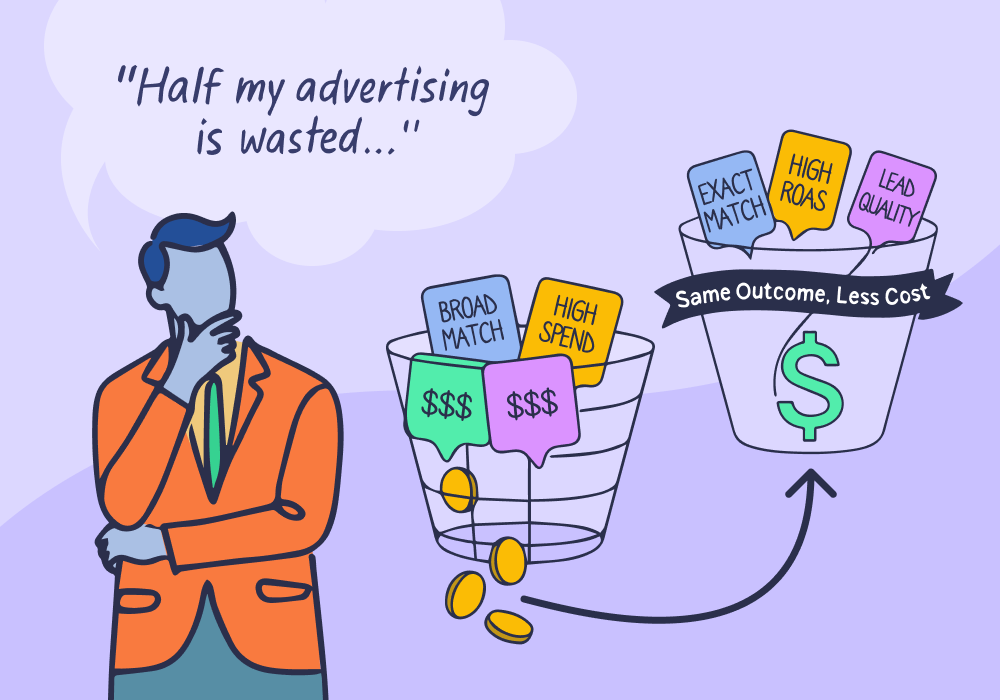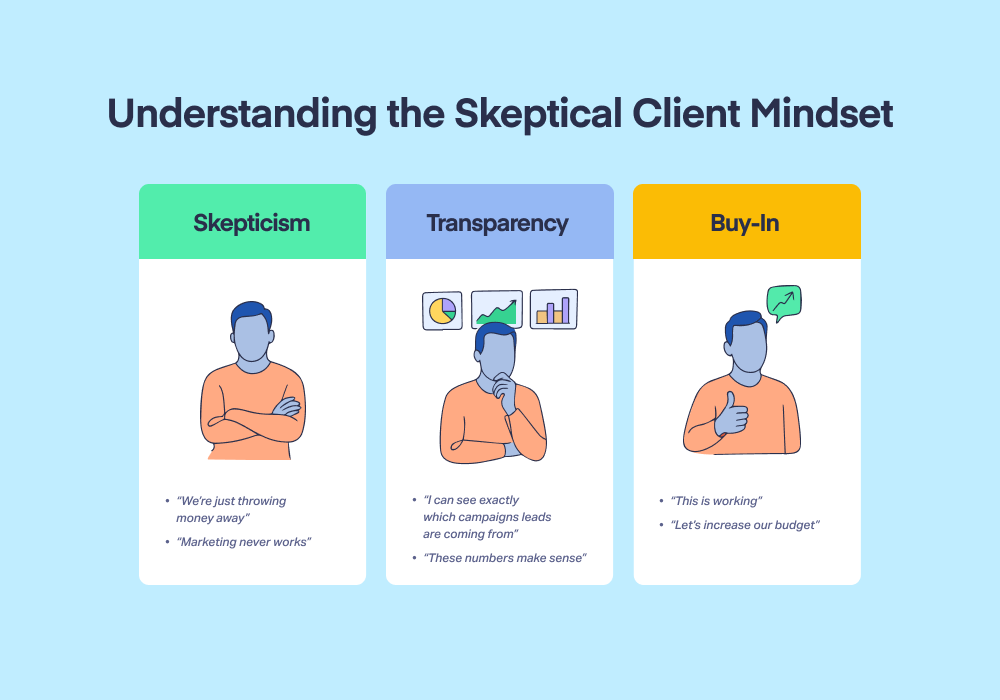
"Half the money I spend on advertising is wasted; the trouble is, I don't know which half."
John Wanamaker said this over a century ago, yet it perfectly captures what your clients are thinking right now. They see clicks coming in across dozens of keywords, with no idea that some are driving pure junk while others generate hundreds of thousands in revenue.
Here's the real problem: without knowing which campaigns actually convert prospects into customers, you can't convince clients to trust your campaign optimization promises. You might boost click-through rates by 30% or increase conversions by 50%, but if those "optimized" campaigns are just bringing in more tire-kickers, you haven't improved business outcomes at all.
That's where true campaign optimization comes in—focusing on the leads that actually matter.
What Campaign Optimization Really Means
Campaign optimization isn't about tweaking ad copy to get more clicks. It's about systematically identifying which marketing activities drive valuable customers and eliminating those that don't.
Most marketers optimize for the wrong metrics. They chase higher click-through rates, lower cost-per-click, and increased conversion volume—all while missing the bigger picture. A campaign generating 100 conversions monthly might look successful until you discover only five become paying customers.
Real campaign optimization focuses on three key areas:
- Lead quality over lead quantity: Would you rather have 100 leads worth $500 each or 20 leads worth $5,000 each?
- Customer value attribution: Which campaigns actually generate customers who buy, not just prospects who browse?
- Waste elimination: Where are you spending money on activity that never converts to revenue?
When you can trace each lead back to its source campaign and track whether they become customers, optimization decisions become clear and defensible.
The Foundation: Complete Lead Tracking
Everything we're about to discuss hinges on one critical capability: tracking the complete journey of every lead from first click to final sale. Without this foundation, campaign optimization amounts to little more than guesswork.
Why Standard Analytics Fall Short
Google Ads shows you that someone clicked your ad and filled out a form. Google Analytics tells you about website behavior. Your CRM tracks sales conversations. But none of these systems connect the dots to show you which specific marketing touchpoint generated which paying customer.
This fragmented view creates optimization blind spots. You might see that Campaign A generated 50 conversions while Campaign B generated 20, leading you to conclude Campaign A is more successful. But what if Campaign B's 20 leads resulted in $100,000 in sales while Campaign A's 50 leads all turned out to be spam or never become paying customers?
What Complete Lead Tracking Looks Like
Effective campaign optimization requires tracking systems that capture:
- Marketing attribution for every lead: Which campaign, keyword, and ad brought them in? What was their complete journey across multiple touchpoints?
- Individual lead profiles: Contact information, qualification status, and all interactions with your company stored under one lead record.
- Lead value tracking: Quote values, sales values, and customer lifetime value connected to specific leads and traced back to their original marketing source.
- Quality indicators: Which leads become customers, which are spam, which are existing customers seeking support, and which are competitors doing research.
When you can see that "John Smith came from Google Ads keyword 'emergency plumbing,' called twice, received a $2,500 quote, and became a $3,200 customer," optimization decisions become data-driven rather than assumption-based.
Read More: Path to $1M MRR: Agency Shifts from Vendor to Partner w/ Advanced Reporting [Case Study]
How to Identify Campaign Waste
The first step in effective campaign optimization is understanding where waste actually occurs. Platform analytics show you conversion volume, but they don't reveal conversion quality.
Common Sources of Hidden Waste
Broad keyword targeting attracts irrelevant traffic that converts to low-quality leads. A keyword like "roofing" might generate 50 leads monthly, but if 45 are from people just researching prices with no intention to buy, you're wasting 90% of that budget.
Poor audience targeting reaches unqualified prospects who consume budget without generating revenue. Geographic targeting that extends beyond your service area creates leads you can't serve.
Platform-optimized campaigns that chase cheap clicks often sacrifice lead quality. A campaign with a $2 cost-per-click might seem efficient until you realize those leads never convert to customers.
The Real Cost of Poor Lead Quality
Beyond wasted ad spend, poor-quality leads consume sales team time, skew performance metrics, and create false confidence in underperforming campaigns. Every unqualified lead costs time to process and disqualify—time that could be spent closing qualified prospects.
When you can track individual lead outcomes and trace them back to specific campaigns, hidden waste becomes obvious. You'll often find that campaigns appearing successful based on conversion volume are actually generating mostly junk.
Building Your Campaign Optimization Framework
Systematic campaign optimization addresses performance issues at multiple levels, from broad budget allocation down to specific targeting parameters.
Start with Lead Quality Assessment
Before optimizing anything, establish clear criteria for what makes a lead valuable. Consider factors like:
- Budget alignment: Do they have the budget for your services?
- Timeline urgency: Are they looking to buy soon?
- Geographic fit: Are they in your service area?
- Service match: Do they need what you actually offer?
Track which campaigns consistently produce leads meeting these criteria. This becomes your optimization north star.
Read More: The Quantity → Quality Shift: Agency Boosts Quality Calls & Conversion Rates by 30% [Case Study]
Macro-Level Optimization: Budget Allocation
Focus on the biggest impact opportunities first. Use lead value data to reallocate budget from underperforming channels to those with proven results.
For example, you might discover that Google Ads generates 60% of total leads but 85% of qualified customers, while Facebook generates 25% of leads but only 8% of customers. This insight justifies shifting budget toward Google despite higher cost-per-click.
Micro-Level Optimization: Campaign Refinement
Within successful channels, identify which specific campaigns, ad groups, and keywords deliver the best results. Use lead quality patterns to refine targeting, focusing on demographics and behaviors that correlate with valuable customer acquisition.
Test based on lead quality, not just conversion volume. Campaign variations that generate fewer total conversions but more qualified prospects often deliver superior ROI.
Data-Driven Budget Decisions
Moving beyond platform recommendations and industry benchmarks, effective campaign optimization focuses spending on demonstrated performance rather than assumed effectiveness.
Zero-Based Budget Planning
Instead of incrementally adjusting existing budgets, start from zero and allocate spending based on proven lead value and ROI. This approach often reveals significant misalignment between spending and actual results.
A campaign generating leads worth $2,000 each justifies higher spending than one producing $200 leads, regardless of volume differences.
ROI-Based Scaling Decisions
Use historical lead performance to guide scaling decisions. Campaigns with proven track records of generating valuable customers can support increased investment, while those producing questionable results should receive reduced funding.
This approach often results in fewer total leads but significantly higher revenue per marketing dollar invested.
Moving Beyond Vanity Metrics
Effective campaign optimization requires marketers to focus on metrics that directly impact business results rather than platform-specific performance indicators.
Lead Quality Over Lead Quantity
Optimize for lead quality and value rather than lead quantity. A campaign generating 20 qualified leads monthly often outperforms one producing 100 unqualified inquiries, despite appearing less successful in platform dashboards.
Revenue Connection
Track leads from initial contact through final sale to understand which campaigns generate customers who actually buy. This revenue attribution reveals the true ROI of different optimization strategies.
When you can show exactly which campaigns produce customers versus those that just generate inquiries, optimization decisions become straightforward and defensible.
Building Client Trust Through Transparency
Transparent reporting focused on business outcomes builds client confidence while providing the data foundation necessary for effective campaign optimization.
Lead-Level Reporting
Provide clients access to individual lead details so they can see exactly which campaigns generate which customers. This transparency eliminates questions about campaign effectiveness by making results tangible and verifiable.
Real-Time Performance Visibility
Offer clients ongoing visibility into campaign performance through dashboards showing lead quality, conversion patterns, and ROI trends. Real-time access reduces the need for lengthy reporting meetings while building trust.
When clients can examine actual lead records and trace them back to specific campaigns, campaign optimization becomes collaborative rather than defensive.
Turning Campaign Optimization Into Growth
Effective campaign optimization does more than eliminate waste—it creates scalable systems for sustainable growth through systematic identification and expansion of what actually works.
The key to successful campaign optimization lies in measuring what matters: qualified customer acquisition rather than platform-specific metrics. When you can prove which campaigns generate valuable customers and systematically eliminate those that don't, optimization becomes a growth engine rather than a cost management exercise.
This approach requires comprehensive measurement infrastructure that tracks complete customer journeys from initial marketing touchpoint through final sale. Without this foundation, optimization efforts remain guesswork-based rather than data-driven.
Ready to transform campaign optimization from guesswork to growth strategy? Start your free 14-day trial of WhatConverts and discover which campaigns actually drive valuable customers.
Get a FREE presentation of WhatConverts
One of our marketing experts will give you a full presentation of how WhatConverts can help you grow your business.
Schedule a Demo
Grow your business with WhatConverts







